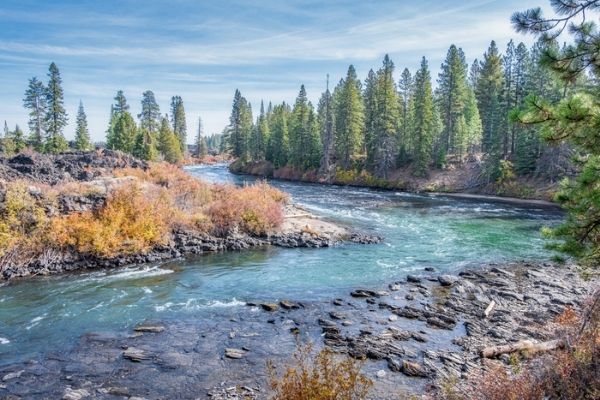The Deschutes River Conservancy is receiving $1.3 million as part of the Bureau of Reclamation’s $20.5 million package for a suite of 13 long-term drought resiliency projects in five Western states. The Deschutes Basin was the only project site to be selected in the Northwest.
The funding will be used by the DRC, its irrigation district partners in the Deschutes Basin Board of Control, and its municipal partners within the Central Oregon Cities Organization, to formalize and operate a Water Bank that can deploy a suite of time and resource-efficient mechanisms to move water between users and the river, to meet the most pressing demands.
The Bank will rely wholly on voluntary actions and will be locally controlled by bank partners, including the irrigation districts that hold the majority of the water rights in the basin. Bank activities will be focused on restoring critical streamflows, assuring that farmers get the water they need to grow crops, and securing future water for growing urban communities.
The grant will also fund critical elements of drought management, including enhanced metering and monitoring of water diversions, the ability to better forecast climate conditions and drought impacts on reservoir and river levels, and a strategy to tie these forecasts to needed responses in an accessible and web-based platform.
The formal establishment of a comprehensive bank builds on and ties together the extensive water management work already happening in the basin.
Irrigation districts are aggressively piping canals to conserve water.
DRC, Central Oregon Irrigation District, and Deschutes Soil and Water Conservation District are funding and implementing on-farm efficiency projects that save additional water.
The DRC’s 2022 water bank pilot is underway, providing interested Central Oregon Irrigation District patrons a cash payment to forego use of their water to help North Unit Irrigation District and the river.
Additional longstanding programs include the DRC’s Annual Instream Water Leasing Program that restores streamflows, and the Deschutes Groundwater Mitigation Program which provides a framework for cities to secure new water supplies. The market-based tools rely on the use of incentives to allow for water to move on a voluntary basis from less-valued uses to higher-valued uses. The Deschutes Water Bank will tie these efforts together, providing a coordinated umbrella to allow basin partners to meet river and community water needs, while greatly increasing water resiliency in the face of climate change and more frequent drought conditions.
The funding could not have come at a better time, says DRC.
Central Oregon is currently in a drought of historical significance. Extraordinary low precipitation, coupled with record-setting heatwaves, and compounded by several years of drought prior to this have resulted in devastation to agricultural communities, critical impacts to fish and wildlife throughout the basin, declining groundwater levels, and increased uncertainty for municipal water supplies.
According to water experts, forecasts for this summer offer no indication that this hot and dry trend will break soon.
“We are living in unprecedented times in the Western United States,” said Kate Fitzpatrick, Executive Director of the Deschutes River Conservancy. “The status quo system of water management is not working for rivers or farmers in the Deschutes Basin, and we’re seeing the consequences in our depleted rivers and in dried up, fallowed fields. Voluntary water banking is one of the ways we envision moving into a more resilient future. Paired with water conservation projects (irrigation district piping and on-farm efficiency improvements) and better stewardship, we feel confident that there will be the water supplies needed for rivers, farms, and communities. We are proud to model with our partners how communities can come together to solve difficult water issues.”
Craig Horrell, President of the Deschutes Basin Board of Control said, “Deschutes Basin irrigation districts are committed to adapting to the changing climate conditions and taking a collaborative approach to improving water reliability in a way that does the most good for farmers, the community, and the environment. The $1.37 million investment in the Deschutes Basin will be utilized to find better and more efficient ways to move and monitor water for years to come.”
“Climate change presents growing challenges to our communities across the West and the natural systems that we all depend on,” said Assistant Secretary for Water and Science Tanya Trujillo. “The Department of the Interior will continue to work with our partners to develop innovative solutions that address the challenges we face.”
The DRC was formed 25 years ago with a mission to restore streamflow and improve water quality in the Deschutes River Basin.
The Bureau’s 13 selected projects are:
Bear River Water Conservancy District (Utah), $2 million
Bella Vista Water District (California), $2 million
Casitas Municipal Water District (California), $2 million
City of Fresno (California), $293,450
City of Gallup (New Mexico), $2 million
City of Grand Junction (Colorado), $300,000
Delano-Earlimart Irrigation District (California), $2 million
Deschutes River Conservancy (Oregon), $1,370,473
North Kern Water Storage District (California), $500,000
Rancho California Water District (California), $2 million
San Bernardino Valley Municipal Water District (California), $2 million
South Coast Water District (California), $2 million
South San Joaquin Municipal Utility District (California), $2 million

